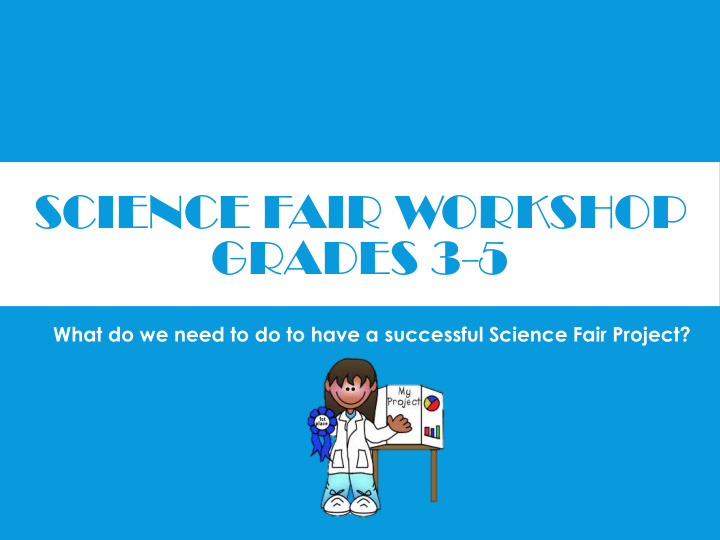



SCIENCE FAIR WORKSHOP GRADES 3-5 What do we need to do to have a successful Science Fair Project?
SCIENTIFIC METHOD OR ENGINEERING DESIGN PROCESS? Your child’s safety form has been signed which means your child’s project idea has been approved! Now use the steps for the appropriate type of project on the next few slides. If your child is investigating a question by performing an experiment, follow the scientific method process (slides 3-5 in the presentation). If your child is creating a solution to a problem by developing a design plan and creating and revising a prototype, follow the engineering design process (slide 6 in the presentation).
COMPARING THE SCIENTIFIC METHOD AND ENGINEERING DESIGN PROCESS
SCIENTIFIC PROCESS • Question -what are you investigating scientifically? • Hypothesis - guess based on a strategy and background info • Background - info that explains how student derived at hypothesis/Research Info listing sources • Materials - list all the things you need to experiment • Procedures - steps you took to find the answer and test hypothesis • Observations - should be measurable • Results - summarize observations • Conclusions - answer the question based on results
MEASURABLE OBSERVATIONS Bar Graph Chart/Table Line Graph These should be in the form of numbers! Something that SHOWS you kept a record of testing and displays the outcome
IMPORTANT TIPS FOR RESULTS… Scientists want to test ONE variable called the “experimental variable” (EV) All other variables remain the same called the “control variables” (CV) This allows a truer result to occur Be sure to pick out your EV and your CV in your project!! Example: I am testing to see if classical music effects plant growth; music is my experimental variable. The plants I test will be the SAME size, SAME kind, in the SAME type container, SAME soil, receive the SAME amount of water/food supplements, access to the SAME amount of sunlight at the SAME time of day, etc. Only one will “hear” the classical music and the others will not.
THE THE EN ENGINEERING INEERING PROC PR OCESS: ESS: • Problem - Choose a real-world problem. Investigate how others have tried to solve it. What could you do to solve the problem? • Design Plan - Develop and sketch a plan for your design. Label needed materials, measurements, etc. • Construction - Build a prototype based on your design plan. • Testing - Test your prototype. See how it could be improved. Revise/improve your prototype and test again (and again and again and again, if necessary). • Creativity - Make sure your solution is unique or solves the problem in a way others have not. Building something that someone else already invented does not show creativity. • Presentation - Show evidence of all steps of your process. You may display photographs to show the stages of the process
DISPLAY IDEAS Note: The project must be displayed on a poster board of some sort; although tri-fold boards are very popular, it does not have to be a tri-fold board. Cover with fabric/Paint backboard Type all parts and proofread Add photographs of the process Add 3-D effects (picture frames, shelves, rods that are attached and can spin or move) Place title above the middle section to save room for process
PROJECT DISPLAY BOARD SAMPLE FORMAT: Title centered and raised above board Materials Question Results Procedures Hypothesis Conclusions Observations Background Info
TITLES SHOULD BE FUN!
FRIENDLY REMINDERS! Photographs that show you testing the question or following your procedures are a GREAT idea…but be careful… DO NOT show pictures of your face . Judging has to be unbiased and you need to remain anonymous for fairness. This is a competition….what can you do to make your project stand out and look sharp?
EXAMPLES OF SCIENCE FAIR PROJECTS: 2017 3 rd Grade winning projects 2017 4 th Grade winning projects 2017 5 th Grade winning projects
Scie cient ntific ific Meth ethod od Title centered and in • large font Typed information • Headings stick out to • readers Colored paper frames • information to make it stick out Colored graphs • Pictures do NOT include • any faces
Engi En ginee eerin ring g Des esig ign Pro roce cess ss Title centered and • raised above the tri-fold Typed information • A theme was given to • the board to match the project idea (Legos) Parts of the process are • clear to readers The variations of testing • and models are evident and clearly labeled Colored pictures of • models Summary of findings •
Title centered and in • Scie cient ntific ific Meth ethod od large letter cutouts Typed information • Headings stick out to • readers (in cut out letters) Colored paper frames • information to make it stick out Colored pictures • Pictures do NOT include • any faces Detailed data tables • Detailed conclusion of • findings
Title centered and • Scie cient ntific ific Meth ethod od raised about the tri- fold Typed information • Creative/fun paper • backgrounds Hanging details for • extra decoration Headings stick out to • readers Pictures do NOT • include any faces Colored pictures to • show the changes in the stains according to different detergents
Recommend
More recommend